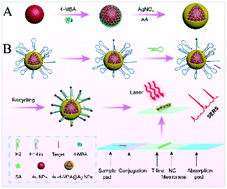A portable SERS reader coupled with catalytic hairpin assembly for sensitive microRNA-21 lateral flow sensing†
Abstract
Nucleic acid lateral flow sensing has drawn great research attention since it has the advantages of being simple, rapid, and cost-effective. However, considering the trace amounts of the nucleic acid targets, its sensitivity is still limited. Although enormous efforts have been devoted to enhancing its sensitivity, developing a simple lateral flow sensing platform with high sensitivity remains challenging. We report a novel lateral flow microRNA-21 biosensing platform based on a portable surface enhanced Raman scattering (SERS) reader coupled with a catalytic hairpin assembly signal amplification strategy. Hairpin DNA probes were anchored on Au@Ag nanotags, and the presence of microRNA-21 triggered the formation of numerous double-stranded DNAs along with the exposure of the biotin groups. By this means, the target was recycled and signal amplification was achieved. The Au@Ag nanoprobes with exposed biotin can be captured on the test line via its interaction with streptavidin. By scanning the strip with a portable SERS reader, the sensitive quantification of microRNA-21 was realized with a detection limit as low as 84 fM. The proposed strategy was employed to detect the target in a serum sample, demonstrating its great potential in amplified point-of-care biosensing for clinical diagnosis.

- This article is part of the themed collection: Analyst Recent HOT articles


 Please wait while we load your content...
Please wait while we load your content...